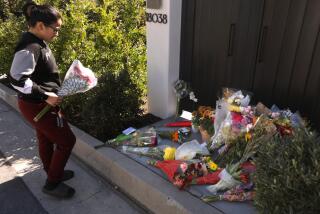Murder Trial Defendant Tells His Side
- Share via
Both sides rested Tuesday night in the Kenneth McKinzie murder trial, after the defendant took the stand and repeatedly denied beating to death an Oxnard woman and dumping her body in a canal.
McKinzie, 39, spent most of the day on the stand, telling a lengthy story about how he ended up selling 73-year-old Ruth Avril’s stereo and giving his daughter the dead woman’s camera and bathrobe.
But, he said, that didn’t mean he killed her.
Defense attorney Willard Wiksell concluded the questioning in dramatic style, holding up an enlarged photo of Avril’s bludgeoned corpse lying in a shallow pool of water.
“Mr. McKinzie, did you throw her in a ditch and leave her like this?” Wiksell asked.
“No,” the defendant answered firmly. “I didn’t.”
He went on to say he was not sure the real killer was the man his own attorney had identified the day before.
Deputy Dist. Atty. Donald Glynn didn’t directly challenge McKinzie’s account but spent several hours methodically drawing out details that he said didn’t jibe with the testimony of two other witnesses who said McKinzie confessed to the killing.
McKinzie was the last defense witness in the two-week murder trial. Closing arguments are scheduled to begin Thursday morning.
If McKinzie is found guilty of murder and at least one of the two special circumstance allegations charged in the case, the trial would advance to a penalty phase in which the jury would be asked to decide whether McKinzie should be executed or sentenced to life in prison without parole.
Prosecutors say McKinzie, an Oxnard resident with a long criminal history, attacked Avril after midnight on Dec. 21, 1995, as she was turning off a light in her garage. During a struggle, they say, McKinzie hit Avril more than a dozen times and threw her body into the trunk of her car.
Allegedly after dumping the body in an irrigation ditch, the defendant went back to Avril’s south Oxnard apartment and stole her stereo, a videocassette recorder, credit cards and presents from under her Christmas tree.
But McKinzie told jurors Tuesday that it didn’t happen that way. Instead, he offered this account:
A few days before Christmas 1995, McKinzie ran into an acquaintance who he knew only as “Little Tommy.” Little Tommy has been identified in court as 21-year-old Donald Thomas, who now lives in Tacoma, Wash. McKinzie said Thomas was with two unidentified “dark-skinned” men. McKinzie said he bought a VCR from Thomas.
He also said he borrowed a black car that Thomas was driving--Avril’s car--and sold the VCR to another friend, Ralph Gladney.
While he was with Gladney, McKinzie thumbed through some credit cards he said Thomas gave him and recognized Avril’s picture. McKinzie said he took the credit cards to a third friend, Theresa Johnson, who helped him withdraw $440 from two ATMs.
Then McKinzie met up with Thomas again and bought a stereo from him. “After I got the stereo,” he said, “Tommy told me he needed to talk to me. He told me the stuff had come from Ms. Avril’s and she got beat.
“He said they took her and put her in the trunk of the car and took her to Malibu. He told me whatever I do, don’t take none of that stuff to the pawnshop. That’s how it came up,” he testified.
McKinzie told the jury he was upset by the alleged conversation. And frightened.
“I was kind of, like, tripping,” he said. “I wanted to give the stuff back to him. But . . . in the back of my head, I was thinking I was already caught up.”
McKinzie said he left Thomas and drove back to Johnson’s house, where he smoked cocaine with her and stashed the stolen stereo and other goods.
It was at this point, according to Johnson’s trial testimony, that McKinzie tearfully confessed to killing Avril and stealing her belongings. But McKinzie told the jury that Johnson lied.
Gladney also testified at a prior court proceeding that McKinzie admitted killing Avril. Gladney, who died in June, also lied, the defendant said.
Under lengthy cross-examination by Glynn, McKinzie stood by his account. The prosecutor never raised his voice and never asked an antagonistic question. Instead, he slowly reviewed McKinzie’s account, pinpointing vague areas and fleshing out details.
At times when Glynn could have posed simple objections to McKinzie’s storytelling, he allowed the defendant to spin long narratives of events on the night Avril died.
“Why did he give you the car?” Glynn asked at one point.
“I told him I didn’t want to walk with that VCR. He told me I could use the car,” McKinzie answered.
“This is what happened, sir,” he continued. “Tommy told me he had a VCR. I told him to get it. I told him if he’s going to give me the VCR, I’m not going to walk with it.”
McKinzie admitted he knew Avril. He acknowledged that days before her slaying he helped her carry a Christmas tree into her apartment. He said he also helped carry her groceries on occasion.
As for the two mystery men with Thomas, McKinzie said he thought they were Latino. He said they may have been involved in the killing, he wasn’t sure.
Though his attorney had earlier identified Little Tommy as the real killer, McKinzie said he was no longer sure about that. “I’m not saying Tommy killed that lady,” he said. “I wasn’t there.”
More to Read
Sign up for Essential California
The most important California stories and recommendations in your inbox every morning.
You may occasionally receive promotional content from the Los Angeles Times.













